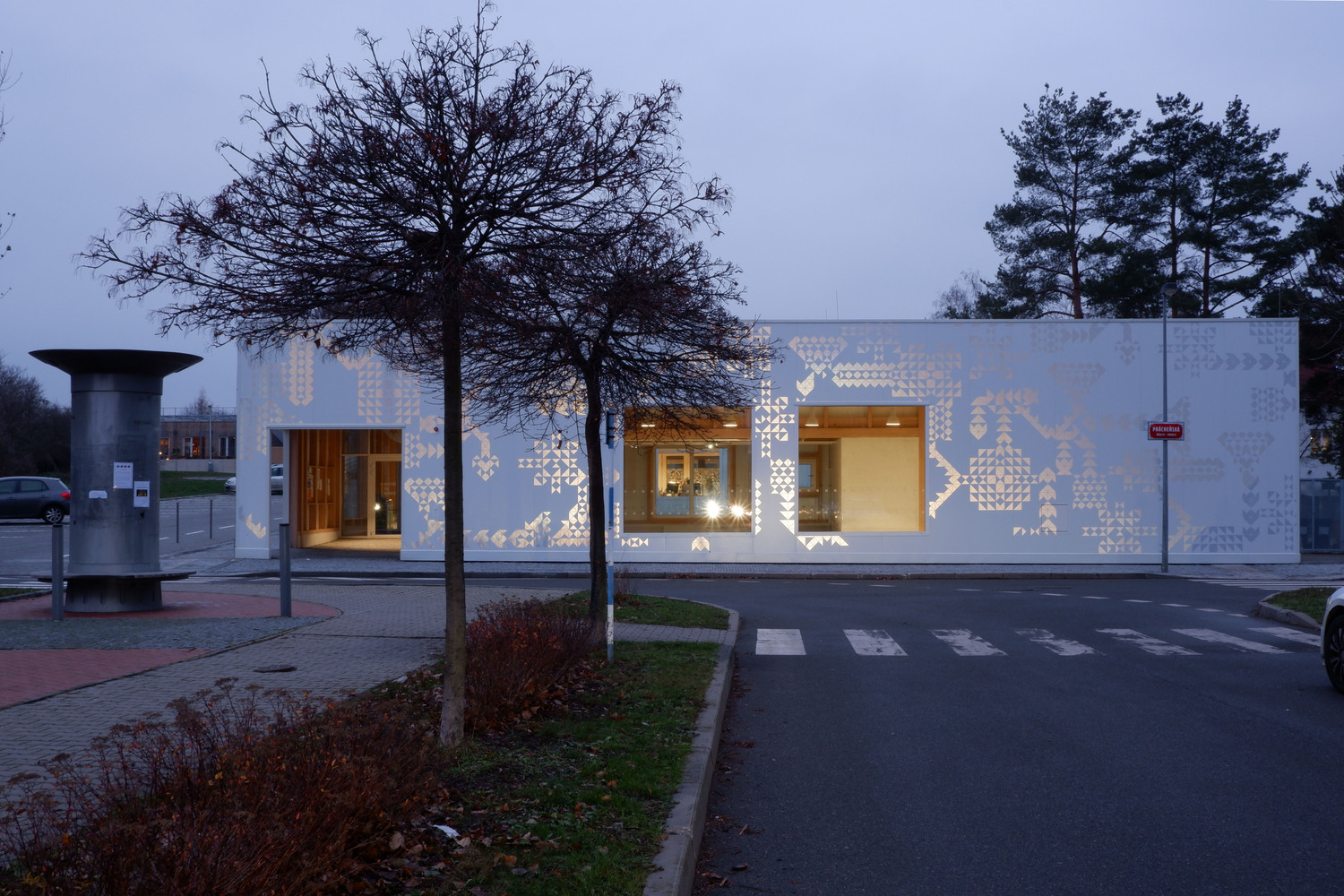Raakspoort Haarlem Bolles + Wilson
2012-02-08 00:00
架构师提供的文本描述。转型过程,尤其是那些与哈勒姆这样细腻的历史城市有关的过程,是复杂而持久的。在Raaks项目中,经过十多年的时间才从经过深思熟虑的“城市大师级计划”(Donald Lambert-Kraaijvanger Urbis)到2011年10月开始的一系列研讨会和计划重新思考最终的合奏。
Text description provided by the architects. Transformative processes, particularly those relating to delicate fine-grained historic cities like Haarlem are complex and protracted. In the case of the Raaks project it took more than ten years to evolve from the considered Urban Masterplan (Donald Lambert - Kraaijvanger Urbis) through a sequence of workshops and program rethinks to the final ensemble, which opened in October 2011.
从一开始,Bolles Wilson就被赋予了在这个紧密拥挤、高度城市重建区的最外面的街区的责任-事实上(并且按照规划的总体计划)几乎与邻近的小规模城市结构-一个街区-紧密地交织在一起。边缘街区必须屏蔽(交通)和邀请(行人),它必须发出信号,并尊重地在确定中世纪城市历史界限的立面序列中占据一席之地。举办现场讲习班的有邻里代表、城市代表、开发商和建筑师-Bolles Wilson、Claus en Kaan、Jo Crepain和Kraaijvanger Urbis(他们还负责下面的大面积停车场)。
At the outset BOLLES+WILSON were given responsibility for the outermost block of this close packed, highly urban redevelopment precinct - which as it turns out (and as the masterplan prescribed) intertwines almost seamlessly with the adjacent small-scale urban fabric - a neighbourhood. The edge block must both shield (traffic) and invite (pedestrians), it must signal and respectfully take its place in the sequence of facades that define the historic limit of the medieval city. Initiating site workshops brought together neighbourhood representatives, city representatives, developers and architects - BOLLES+WILSON, Claus en Kaan, Jo Crepain and Kraaijvanger Urbis (who also had responsibility for the large format carpark below).
复杂的功能组合开始于上层的一家大型和七家较小的电影院,一家地下赌场,以及停车场下面的一家赌场(供赌客和赌客使用)。即使在这一阶段,这两种功能也被分割成一条平分通道,从可见的、有代表性的外立面到联网的街区内部。在这个阶段,关于无窗生物库房单体的规模和历史参照的问题产生了一个像电影屏幕一样的正面,几乎是一个流行的图形,一个巨大的屏幕印刷的历史性哈勒姆计划,悬置在电影放映屏幕的反面(城市的稳定形象-媒体的短暂现实)。欢迎大家(很正确)并不感到好笑。
The complex functional mix began with one large and seven smaller Cinemas on the upper levels, a subterranean Casino and below that a parking deck (for croupiers and gamblers). Even at this stage the two functions were divided by a bisecting passage leading from the visible and representative outside facade to the networked block interior. The question of scale and historic referencing of the windowless Bioscoop monolith at this stage engendered a cinema screen-like facade with an almost pop graphic, a giant screen-printed historic Haarlem Plan, suspended on the reverse side of cinema projection screens (the stable image of the city - the fleeting reality of media). Welstand were (quite rightly) not amused.
在这一点上,电影院转入地下,赌场殖民上层。他们也不需要什么窗户(太分散注意力,严重的事情是把钱扔到机器上)。此时,还引入了一种复杂的钢骨架,将上层功能挂在下面的大型影院之上。在某种程度上,赌场变成了市政厅。这是一个期待的机会,可以调查缺失的窗户,并发明一种可以安装在墙面线上,与砖瓦齐整,或以建筑物表面为傲的柜子类型。
At this point the cinema went underground and the Casino colonized the upper levels. They also required few windows (too distracting from the serious business of throwing money into machines). At this time also a complex steel skeleton was introduced to suspend upper functions above large format cinemas below. At a certain point the Casino became a City Hall. This was the awaited opportunity to investigate missing windows and to invent a casement type that can be installed either set back from the facade line, flush with the brickwork or proud of the buildings surface.
当然,市政厅是一座具有代表性的重要建筑-新用户承担起他们的责任,在奥尔德曼·克里斯·范·韦尔森(Chrisvan Velzen)敏锐的野心的指引下,又发起了一系列设计研讨会。“别忘了钟楼”和“想杜克”是他的指示。其结果是开发了一种铰接式砖皮-一种由阴影条纹和平地组成的纹理,带有较浅颜色的灰泥接缝。此外,在这一点上,必要的整体体积被按摩成一个哈勒姆适当的尺度与角落的挫折,和规模减少体积清晰度。Henk D ll办公室已经设计了一个新的哈勒姆市政厅;他们现在作为城市管理内部的建筑师参加了讲习班。
A city hall is of course a significant and representative building - taking up their responsibility the new users instigated another series of design workshops steered by the perceptive ambitions of Alderman Chris van Velzen. 'Don't forget the clock-tower' and 'think Dudok' were his instructions. The result was the development of an articulated brick skin - a texture of shadow stripes and flat fields with a lighter coloured mortar joint. Also at this point the necessary overall volume was massaged into a Haarlem appropriate scale with corner setbacks, and scale reducing volumetric articulations. The office of Henk Döll had already designed a new Haarlem City Hall; they now joined the workshop as architects of the city administration interiors.
在项目演变的早期,讨论了在生物库房遗址上保存十九世纪建筑的问题。可以想象,这与新的用途有些不相容。另一种策略是,博尔斯·威尔逊选择各种具有象征意义和精细工作的部件,放在一边,仔细修复,并随后整合到新的区块中。采用卡洛·斯卡帕的维罗纳技巧,在支撑墙壁前悬挂象征碎片,这绕过了模仿,并为专注的观众提供了历史性的分层,一种使局部时刻生动化和清晰化的潜台词。
Early in the project evolution the preservation of the nineteenth century building on the Bioscoop site was discussed. It was as one can imagine somewhat incompatible with the new use. The alternative strategy was for BOLLES+WILSON to select various emblematic and finely worked components to be put aside, carefully restored and subsequently integrated into the new block. The adoption of Carlo Scarpa's Verona technique of suspending signifying fragments in front of supporting walls here circumvents pastiche and offers for the attentive viewer a historic layering, a subtext that animates and articulates localised moments.
这两尊雕像曾经可能引发了一场关于“美德”或“谨慎”的讨论,如今却发现自己栖息在一个量身定做的角落架子上,观察着内部的广场,或者像一个锚定天使一样,插入车流和停车场入口。其他拱门、雕塑、雕刻的石雕船浮雕和锚定熨斗都被仔细地放置在充满生气的街道空间、盲墙和通道上,这些通道将连接内部(Raaks Kwartier)和外部世界-另一种有序和编排的空间展开-平分开来。
Two statues which may once have triggered a discourse on 'virtue' or 'prudence' now find themselves perched on a tailor-made corner shelf surveying the inner square, or thrust as anchoring angel into the flux of traffic and car-park entrance. Other arches, sculptures, carved stone ship relief and anchoring irons are carefully placed to animate street spaces, blind walls and to the passage, which bisects the block connecting the inner (Raaks Kwartier) and the outer world - another sequenced and choreographed spatial unfolding.
室内-多尔负责室内设计、地板规划和装修。根据荷兰公共建筑的资格证书,该建筑在可持续性方面得分为8分(满分10分)。公众从紫禁城进入新大厅,设有柜台、咨询室和自助服务点。大厅和它的阁楼是天气,宽和轻。上层由三个城市部门组成的灵活和开放的工作空间-一个经典的办公室,开放的工作区,会议室和相遇空间的组合。建筑氛围的灵感来自17世纪哈勒姆画家朱迪思·莱斯特(Judith Leyster)的“Pekelharing”。安静的几何背景突出色彩的前景,原则的对比形式,材料和颜色也发现在内部的拉克斯波尔特,-安静的中性工作空间,动画相遇的空间。
INTERIOR – Döll was responsible for the interior design, floor planning and finishing. The building scored 8 (out of 10) in terms of sustainability, according to the Dutch GPR-qualification for public buildings. From the Zijlvest the public enters the new hall, with counters, consultancy rooms and self-service points. The large hall with its mezzanine is synoptic, wide and light. The upper floors consist of flexible and open workspaces for three city departments – a combination of classical offices, open work areas, meeting rooms and encountering spaces. The inspiration for the atmosphere of the building is the 17th century painting ‘Pekelharing’ from the Haarlem painter Judith Leyster. Quiet geometrical background + protruding colourful foreground, principles of contrasting form, material and colour found also in the interior of the Raakspoort, – quiet neutral workspaces, animated encountering spaces.
 举报
举报
别默默的看了,快登录帮我评论一下吧!:)
注册
登录
更多评论
相关文章
-

描边风设计中,最容易犯的8种问题分析
2018年走过了四分之一,LOGO设计趋势也清晰了LOGO设计
-

描边风设计中,最容易犯的8种问题分析
2018年走过了四分之一,LOGO设计趋势也清晰了LOGO设计
-

描边风设计中,最容易犯的8种问题分析
2018年走过了四分之一,LOGO设计趋势也清晰了LOGO设计










































































